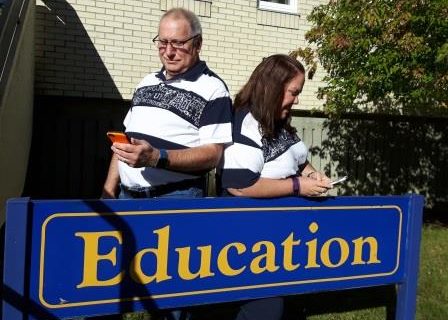
By
Michael Nantais and Jaqueline Kirk
September 2017
Print Version
What you need to know
The purpose of this study was to investigate the case of a rural high school’s initiative to provide each student in grades 9 to 12 with a digital device to be used in the classroom and at home for learning. We examined the process of implementation, the successes, and the challenges from the perspectives of the administration, the teachers, the students, and the parents. In this particular high school, we found that while there were challenges that had to be overcome the teachers and the administrators worked collaboratively to make the implementation a success.
Why this research is important
As technology progresses, educators seek ways that will offer students enhanced learning opportunities with the use of technology. Individuals now have the opportunity to create, access, store, and share large amounts of information within devices that fit into their pockets. The use of tablets and smartphones within classrooms is evolving. Rather than asking students to leave their phones in their lockers or asking them to deposit their phones into the basket at the front of the room, teachers are encouraging students to bring their digital devices and to use them to support their learning. As individual personal devices become more common in classrooms, it is imperative that research be conducted to examine the effective use of these devices for learning. Scholars, such as Marshall McLuhan and Neil Postman, suggest that there are always trade-offs when we use technologies and media. It is important to understand and critically examine the effects and reasons why we use technology, including how and why they are used in schools. With increasing use of digital technologies, we see a growing need for teaching youth to be critical consumers and creators of media.
How this research was conducted
The researchers gathered information about the implementation, use, and outcomes of the initiatives by interview with school division administrators, the computer coordinator, the school Principal, several teachers, and surveyed students and parents. School documents and classroom observations rounded out the data. The data were analyzed to help us understand and document the process, implementation, successes, challenges, and failures encountered.
What the researchers found
The process of implementation was crucial. Infrastructure was in place and planning was deliberate, and leadership at the division and school level was vital. Students were given a choice and, while many teachers desired that students all have the same device, our interpretation was that giving students a choice was a major reason for the success of the initiative. Students made use of laptops, tablets, and smartphones. Students learned to collaborate, and problem solve together so teachers were freed from technology problem solving and could focus on teaching and learning. Furthermore, the variety of devices prevented teachers from teaching for, and with, a specific software and their lessons tended to require students to find a variety of ways to illustrate their understanding.
We observed that the learning environment supported risk-taking, creativity, collaboration, independence, problem-solving, and better communication. This environment resulted in deeper learning, faster access to information, and more student-centred pedagogy.
Participants also described several challenges that were addressed. To start, infrastructure to support individual devices has to be in place and due to the nature of technology people must be prepared for the inevitable glitches that will take place when more devices are infused into an environment.
Other challenges included: teacher resistance, students forgetting devices or not having them charged, and utilizing devices appropriately to decrease distractions.
How this research can be used
While every school and community are different, schools and divisions wishing to embark on a similar initiative could use the findings of this study to inform their work. Learning from this case could assist in planning and identifying and responding to potential problems. Findings such as ensuring infrastructure is in place, preparing teachers, parents, and students for the change are important considerations for implementation.
About the Researchers
Keywords
- computers
- education
- rural schools
Publications Based on the Research
Nantais, M., & Kirk, J. (2017). A case study of a 1:1 computing initiative in a rural high school. MERN Journal, 14, 15-20.
Nantais, M., & Kirk, J. (2016). 1:1 Computing in a rural high school: A case study. CAP Journal, Fall, 38-41.
Editor: Christiane Ramsey
Read more BU Research
Research at Brandon University follows comprehensive policies designed to safeguard ethics, to ensure academic integrity, to protect human and animal welfare and to prevent conflicts of interest.


